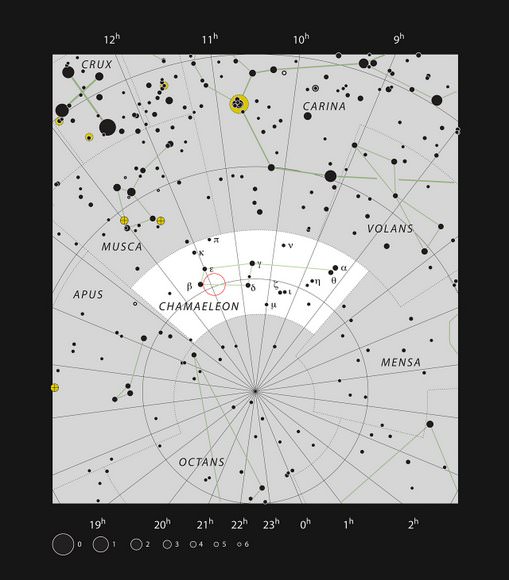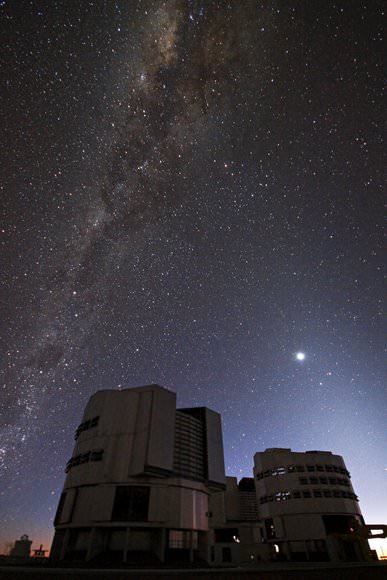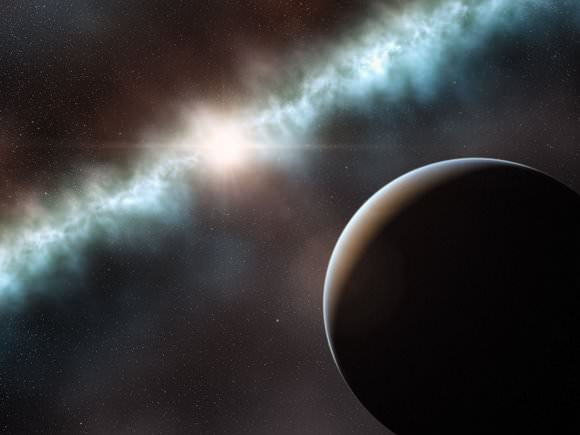[/caption]
An international team of astronomers peering at a young star in the constellation Chamaeleon have detected a smaller companion — a dust-shrouded brown dwarf, or perhaps a planet — that appears to be carving out a large gap in the stellar disk. The discovery is a first: Although planets have been spotted before in more mature disks, this is the first detection of a planet-sized object in the disk around a young star.
Planets form from the disks of material around young stars, but the transition from dust disk to planetary system is rapid and few objects are caught during this phase. Astronomers are getting ever closer to glimpsing the births of planets, though — today’s announcement comes on the heels of a discovery last week using the Subaru Telescope in Hawaii, of a stellar disk around the star LkCa 15 similar in size to our own solar system, featuring rings and gaps possibly associated with the formation of giant planets.
T Chamaeleontis (RA 1h 04m 09.131s dec -76° 27′ 19.30″), T Cha for short, is a faint, young but sun-like star in the small southern constellation of Chamaeleon, about 350 light-years from Earth. T Cha is about seven million years old.

“Earlier studies had shown that T Cha was an excellent target for studying how planetary systems form,” said Johan Olofsson of the Max Planck Institute for Astronomy in Heidelberg, Germany, one of the lead authors of two related papers in the journal Astronomy & Astrophysics. “But this star is quite distant and the full power of the Very Large Telescope Interferometer was needed to resolve very fine details and see what is going on in the dust disk.”
The astronomers first observed T Cha using the AMBER instrument and the VLT Interferometer (VLTI). They found that some of the disk material formed a narrow dusty ring only about 20 million kilometers (12.4 million miles) from the star. Beyond this inner disk, they found a region devoid of dust with the outer part of the disk stretching out into regions beyond about 1.1 billion kilometers (683.5 million miles) from the star.

“For us the gap in the dust disk around T Cha was a smoking gun,” said Nuria Huélamo, of the Centro de Astrobiología, ESAC in Spain, lead author of the second paper, “and we asked ourselves: could we be witnessing a companion digging a gap inside its protoplanetary disk?”
After further analysis, the team found the clear signature of an object located within the gap in the dust disk, about one billion kilometers, or 621 million miles, from the star — slightly further out than Jupiter is from our own sun.
The astronomers searched for the companion using NACO in two different spectral bands — at around 2.2 microns and 3.8 microns. The companion is only seen at the longer wavelength, which means that the object is either cool, like a planet, or a dust-shrouded brown dwarf.
Huélamo said he hopes future observations will reveal more about the companion and the disk, and explain what fuels the inner dusty disk.
Source: ESO press release. This research is presented in two papers to appear in the journal Astronomy & Astrophysics: Olofsson et al. 2011, “Warm dust resolved in the cold disk around TCha with VLTI/AMBER,” and Huélamo et al. 2011, “A companion candidate in the gap of the T Cha transitional disk.”


“about 1.1 billion kilometers (683.5 billion miles) from the star.”
I know I’m just being nit picky, but you may want to move that decimal point over about three numerals.
Interesting article, we learn more about our universe every day.
“about one billion kilometers, or 621 billion miles, from the star — slightly further out than Jupiter is from our own sun”
Same problem. Isn’t this the same type conversion problems that cost us a Mars mission? Pretty sure Jupiter is about 47 Million miles from the sun.
Sorry, Dan.
Uh, http://wiki.answers.com/Q/What_is_the_distance_of_all_planets_from_the_sun
Thanks for correcting my correction. That’s what I get for rushing to be first.
“Jupiter is about 484 million miles from the sun.”
Thanks for reading, and great catch – billion changed to million!
planet porn
Just look at the rings on that one, oh yeah…
What else is heavenly orbital bodies? 😉
Heh, interesting: I used to hate AU but now it is useful and it isn’t there. Wonder if protoplanetary systems like SI units (chemists involved, I’m sure) or it is just this article.
Anyhow, this giant is ~ 7 AU out, so a bit further than Jupiter (as already noted). Another win for testing close orbiting giants as migrated.